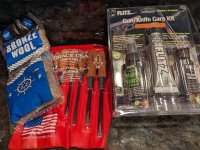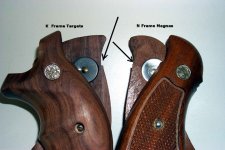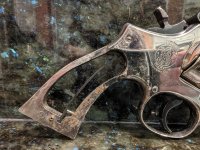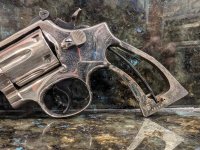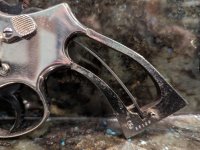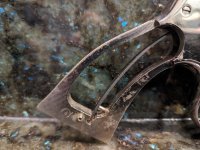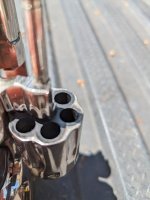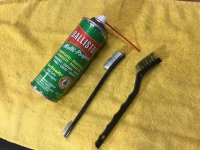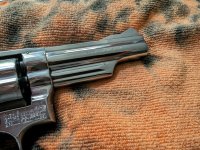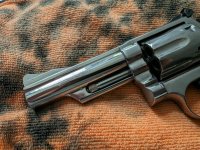The U.S. penny went from being copper to copper plated zinc in October of 1982, so there are some zinc 1982 pennies. For the rust, I agree, bronze wool to remove the rust, then polish with Flitz and finish with oil or wax. You can still use the rubber grips, but now that you are aware of the moisture retention issues that occur under rubber grips, be fastidious with your corrosion prevention. Otherwise, find some wooden stocks that feel good in your hands.
You are using an out of date browser. It may not display this or other websites correctly.
You should upgrade or use an alternative browser.
You should upgrade or use an alternative browser.
19-3 - New to Me
- Thread starter MaxKimber
- Start date
Cotis
Member
Luck sent! You got this, I think it will clean up nicely. Just my $0.02, I think a nickel revolver looks much better with wood grips.
For 1971 vintage, grips would have the black washer, after 1973 silver washer.
Pic for reference of washer color.
The silver colored washer went to mid 90s' after which no washer was used and the machining of the wood produced the washer shape.
There's nothing wrong with using the latest style just to get a target style grip.
The Medina show is June 8 & 9.
Pic for reference of washer color.
The silver colored washer went to mid 90s' after which no washer was used and the machining of the wood produced the washer shape.
There's nothing wrong with using the latest style just to get a target style grip.
The Medina show is June 8 & 9.
Attachments
Last edited:
The way I look at it, the first thing I'd do is to get it in tip-top mechanical shape. Unless you've had experience working on k-frame S&W revolvers, I'd leave the internals alone and get someone very knowledgeable to check it over and correct the problems.
Finally got around to knocking the rust off the frame. I used fine bronze wool and RemOil - thanks for the suggestions. There is some pitting, but overall not too bad. I will hit it with the Flitz once I get around to cleaning the rest of it up.
See before and after pics...
See before and after pics...
Attachments
The U.S. penny went from being copper to copper plated zinc in October of 1982, so there are some zinc 1982 pennies. For the rust, I agree, bronze wool to remove the rust, then polish with Flitz and finish with oil or wax. You can still use the rubber grips, but now that you are aware of the moisture retention issues that occur under rubber grips, be fastidious with your corrosion prevention. Otherwise, find some wooden stocks that feel good in your hands.
Thanks for the correction. I'll ditch the 1983 pennies I saved for this purpose.
FWIW, unless there seem to be issues with the mechanics (timing, lockup, etc.) I wouldn't disassemble it - unless you really just want to tear into it as a learning exercise.Wish me luck...
A few more disassembly videos to watch, then off to the races.
Again, thanks for all the guidance.
If it seems to be functioning correctly, I'd just flush the innards out with a can of brake cleaner - using one of those skinny red straws/nozzles - through the hammer and trigger openings. Keep flushing it out with the brake cleaner until the liquid coming out is clear and clean. Then put a couple of shots of gun oil into those same openings to lube it up and then wipe it down to remove any excess.
I really believe in the "if it ain't broke don't try to fix it" philosophy. I don't want to unnecessarily dissemble and reassemble anything that is already working as intended.
If it has mechanical issues, or if I just wanted to learn how to do it, then THAT is when I'd go through the full disassembly/reassembly process. But that's just me.
YMMV...
Last edited:
Looks like you're making good progress. Can't wait to see the results of applying a little Flitz and some elbow grease!Finally got around to knocking the rust off the frame. I used fine bronze wool and RemOil - thanks for the suggestions. There is some pitting, but overall not too bad. I will hit it with the Flitz once I get around to cleaning the rest of it up.
See before and after pics...
I have watched several videos on proper function checks, what to look for when buying a revolver, etc. My "new" 19-3 passes all the checks. I am still not sure if I will/should disassemble it, my only reason was to thoroughly clean it.
What is the best was to clean the rings on the front of the cylinder on a nickel gun?
What is the best was to clean the rings on the front of the cylinder on a nickel gun?
Attachments
Everyone has a pet method...I use Flitz followed by Simichrome...What is the best was to clean the rings on the front of the cylinder on a nickel gun?
Depends on who you ask and what you intend to do with it.I have watched several videos on proper function checks, what to look for when buying a revolver, etc. My "new" 19-3 passes all the checks. I am still not sure if I will/should disassemble it, my only reason was to thoroughly clean it.
What is the best was to clean the rings on the front of the cylinder on a nickel gun?
Some will say to clean the rings off with bronze wool and oil.
Some will say DON'T BOTHER.
I'm in the "don't bother" camp - because I shoot all my guns.
If you clean them up, the carbon rings on the cylinder face will reappear the first time you shoot it - which is why I'd say don't bother. But that is based on the assumption that you will be shooting it.
On the other hand, if your plan is to make it as pretty as possible and then put it away in your gun safe to preserve it in perpetuity, then I would go ahead and clean the carbon rings off the cylinder face with bronze wool and oil.
Totally your call...
This is what works best for ME. These guys have been doing this a lot longer than me, so heed their instructions and warnings! I have flushed out the innards with circuit board cleaner, as it dries quickly and is safe on most metal parts and usually some plastic. That brake cleaner is always suggested. When in doubt, follow what these guys recommend. I’m gonna try to follow what you do because at 67, I’m still a learning novice!
If you read the label on the Ballistol, the first thing on the front label under the Uses is “guns, leather, knives, tools, locks, marine.” It doesn’t gum up at low temperatures like WD 40. New baseball glove oiling is ok too. Have fun with that gun!
If you read the label on the Ballistol, the first thing on the front label under the Uses is “guns, leather, knives, tools, locks, marine.” It doesn’t gum up at low temperatures like WD 40. New baseball glove oiling is ok too. Have fun with that gun!
Attachments
Engine49guy
Member
If you can disassemble a 1911 you won't have trouble taking apart a SW revolver.
I like the way the guy in the video puts the sideplate screws into a piece of cardboard so they don't get mixed up.
I would definitely remove the sideplate on that old girl following the video, clean and lube the hammer pivot points, if the cylinder release is smooth u can lube it, if it sticks and you plan to remove it just be careful not to launch the spring. If not comfortable leave the trigger and rebound slide in place but it's really not that difficult.
Good luck !
I like the way the guy in the video puts the sideplate screws into a piece of cardboard so they don't get mixed up.
I would definitely remove the sideplate on that old girl following the video, clean and lube the hammer pivot points, if the cylinder release is smooth u can lube it, if it sticks and you plan to remove it just be careful not to launch the spring. If not comfortable leave the trigger and rebound slide in place but it's really not that difficult.
Good luck !
I still have not got around to shining up the new toy yet, but I will... promise.
I did finally have the opportunity to shoot it. It shot rather nicely...the double action was pretty heavy and the single action was very crisp.
Coincidentally, I also had the opportunity to look at my Dad's model 19, turns out his is also a dash 3. My Dad's 19-3 has a very different finish though, he said his has an Armoloy finish. Sort of a matte nickel or brushed chrome look. Interesting...
I did finally have the opportunity to shoot it. It shot rather nicely...the double action was pretty heavy and the single action was very crisp.
Coincidentally, I also had the opportunity to look at my Dad's model 19, turns out his is also a dash 3. My Dad's 19-3 has a very different finish though, he said his has an Armoloy finish. Sort of a matte nickel or brushed chrome look. Interesting...
The shining has begun...
Well, I finally got around to polishing, or should I call it cleaning the "new" 19-3. I spent a little time on the barrel, with Flitz, and WOW, the dirt that came off. See the pics, that was a brand new orange microfiber. Taking advice from the group, I am taking slow and seeing positive results.
Well, I finally got around to polishing, or should I call it cleaning the "new" 19-3. I spent a little time on the barrel, with Flitz, and WOW, the dirt that came off. See the pics, that was a brand new orange microfiber. Taking advice from the group, I am taking slow and seeing positive results.
Attachments
Regarding the original and/or other recommended wooden grips, what is the correct verbiage I should be searching to find handles to fit the 19-3?
You want Goncalo Alves Target, and what you will find most often is "with speed loader cut out" but your revolver wore an earlier version of these stocks, and we usually call them "Footballs."
You can easily see the difference, the speed loader cutout has a perfectly cut arc under the cylinder release, it looks like a quarter circle. The earlier stocks you need do not have this quarter circle, instead it appears more like a football sitting diagonally.
Difficult to describe with words -- EASY to see when you see them. Start running searches for GONCALO ALVES TARGET and you should see pictures.
What do the other markings-stampings under the grip mean?
All the other marks all over the frame, the yoke and wherever else you spot them were used internally by S&W during the manufacturing. It allowed builders to get certain parts mated back again with each other if/when they were sent off to be finished. Some marks could denote that it has been through some particular part of the process.
None of the stamps can really tell us anything these days, except in some rare cases. (certain models carried a stamp if a recall had been performed, and very old guns sometimes got a particular stamp when it was returned to the factory for service.)
I do believe your 19 was possibly in the range where you might find a stamped "N" on the frame denoting that it's original factory finish was nickel.
Similar threads
- Replies
- 3
- Views
- 489

